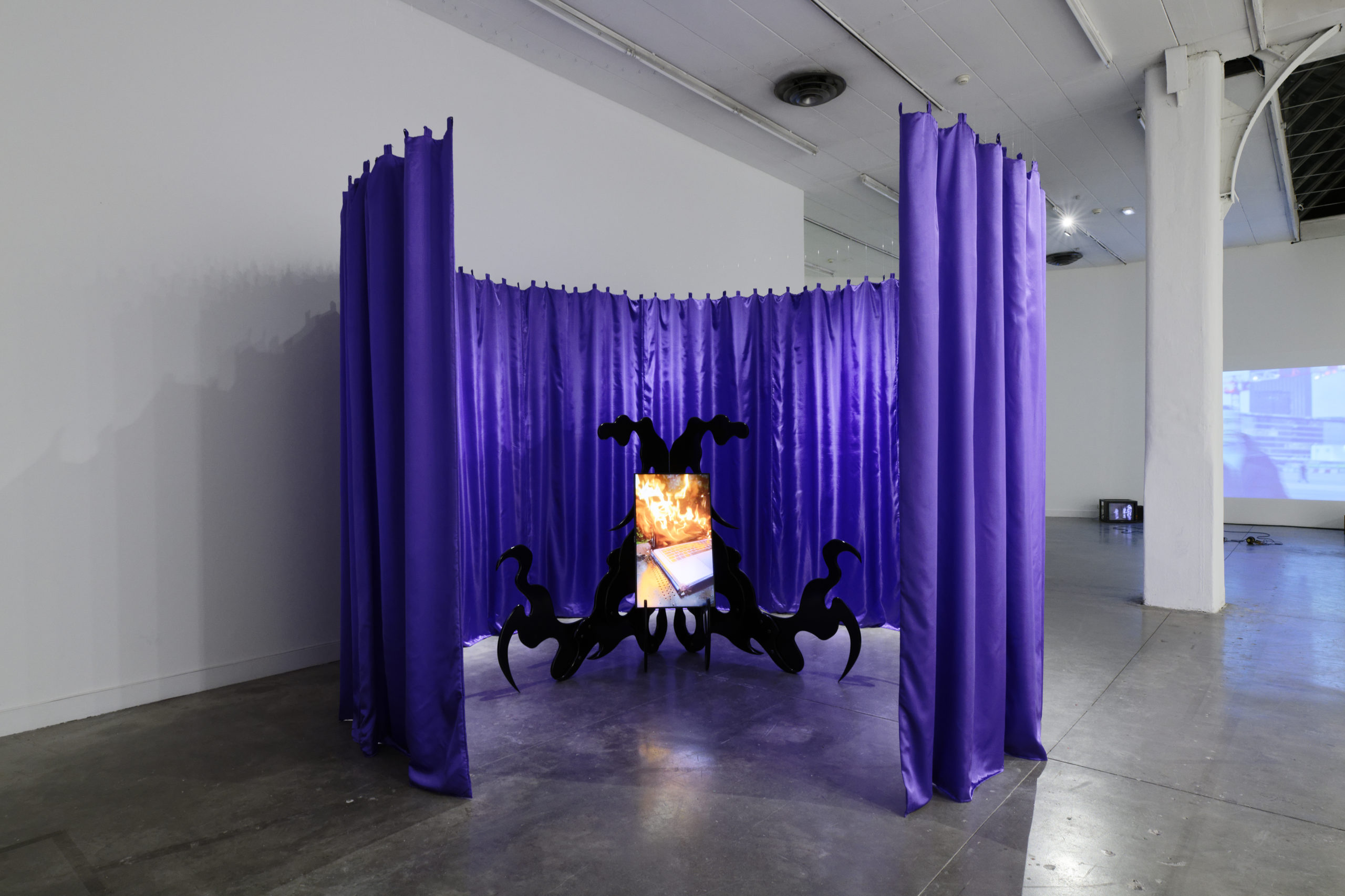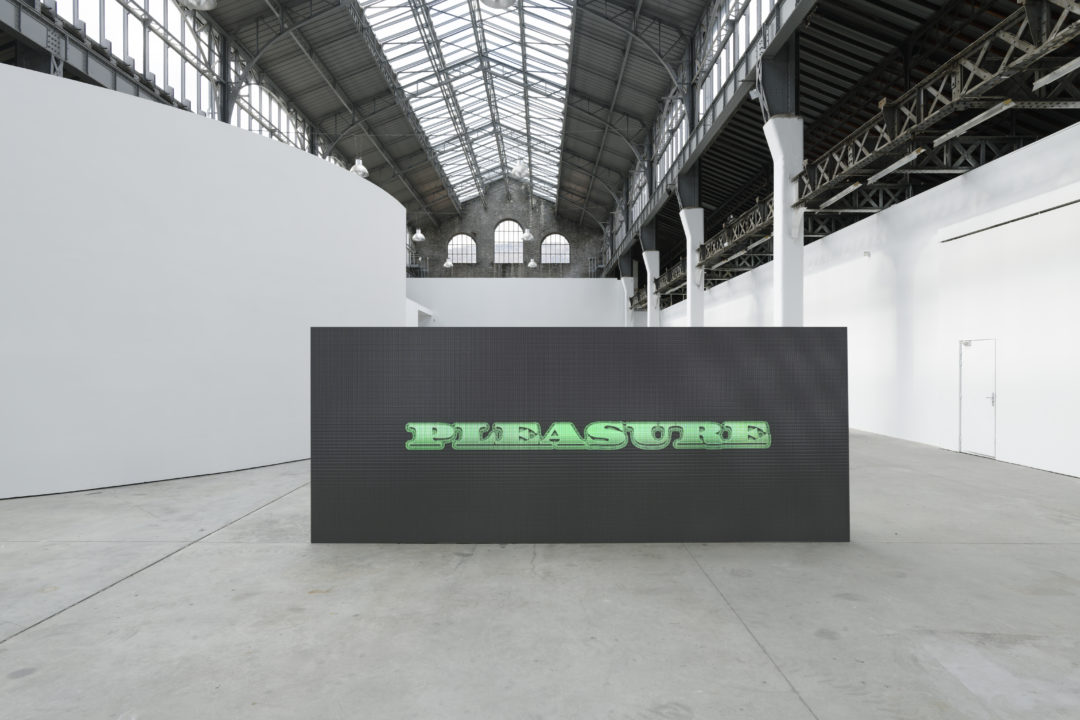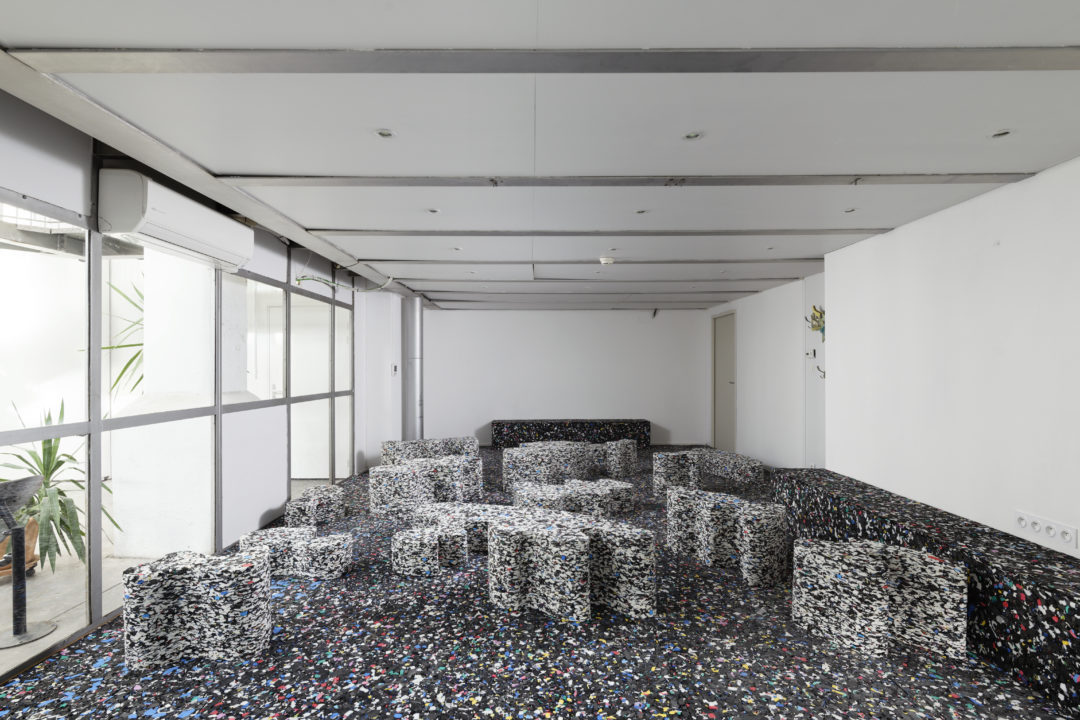Interview with Céline Kopp

Given the difficult context art centres and other art institutions in general are now facing; with budget cuts often proving to be fatal (see the School of Art and Design, Valenciennes), while redesignated sites are being reassigned to other uses (LiFE Saint-Nazaire), news of the reinstatement of a legendary place like the Magasin in Grenoble, is therefore excellent. Recent celebratory events during the reopening to the public were joyfully held in the various exhibition spaces which have been redesigned by Céline Kopp, the new director, along with the constellation of colleagues surrounding her.

Hannah Quinlan & Rosie Hastings, Everything Is Folly That Does Not Give Us Pleasure, 2021.
© Le Magasin CNAC. Photo : Aurélien Mole.
VM: Could we perhaps start by doing a recap of your reopening programme? What type of new identity were you hoping to create for the space and share with the public and the art world?
CK: The reopening programme does in fact provide insight into the new directions of the artistic and cultural projects at the Magasin. It truly was a big party, and the public showed up in great numbers. It was so wonderful to see a queue at the entrance of an art centre! There were people of all ages, representing varied sociocultural profiles, everyone was all smiles. I saw people dancing in the exhibition spaces and children playing! The enthusiasm is due to the fact that the art centre was closed for a long time, but it also shows how art centres can fulfil our needs during a time of transition, when we are faced with a crisis of the imaginary.
When I arrived nine months ago, the Magasin was closed and no longer carrying out its mission of providing service to the public. I made a promise to open up again as quickly as possible, in order to give the place back to its visitors. The goal was to act as quickly as possible, while immediately planting the seeds for future, long-term projects based on our institutional goals.
VM: For those who have yet to make it out there, could you give a virtual walkthrough?
CK: The programme consists of two exhibitions—a Binta Diaw solo show called “Paysages” (Landscapes)—she recently received her diploma from Esad Grenoble—and a group show, La Position de l’amour[1] (The Position of Love), which lends its name to the entire reopening programme. These two exhibitions provide an opportunity to discover the work of artists of varying generations, a multiplicity of voices within a wide diversity of aesthetics. There is also an emphasis on the importance of artistic practice in our everyday lives. The title, The Position of Love, is a reference to writers like bell hooks or Arundhati Roy, who describes “pursuing beauty to its lair,” to the very centre of violence if necessary. Love is not seen as an emotion but rather as a chosen stance in the world, as a way of being, of seeing and listening. The artists gathered together through this exhibition come from very different backgrounds, yet have commonalities in the way they approach artistic practice, in the face of economic hostilities.
Parallel to the exhibitions, we are also inaugurating several new spaces which we have asked the designers at Stromboli[2] to reconfigure: an experimental gallery, a studio space, a children’s gallery and a bookshop entrance hall. Nowadays, you can go to an art centre to see art, but also to take part in discussions, have a coffee, make art, play, read…This is not a place to passively consume cultural content. The idea behind this new configuration is to provide opportunities to create, while exhibiting artistic experimentation, a joyful production, an invitation to the senses to participate in a debate. For example, the welcome desk was made with more than a thousand hand-glazed tiles alongside André Nicolas, a ceramicist from Villard-de-Lans. This is an emphatic way of saying that artists are at the centre of the project, but that the public is, as well.
The children’s gallery, Le petit bocal (The Little Jar), was a very important project, a fundamental aspect of the art centre’s directives, destined for future generations and the stakes they will be facing later on. It is a space for artistic discovery with a strong design element, which will be the setting for specialised programmes[3]. It will also be important for the art centre to make connections with the other cultural actors in the region. I wanted to avoid showing up with an architectural agenda that could have taken years to put in place…
VM: More precisely, which alternative solutions did you find in order to make Eiffel’s architectural design welcoming once again?
CK: We approached things by making slight shifts in order to make the spaces viable again. I should mention that the space had been inaugurated in 1986, nowadays, there are new ways of functioning. I wanted this reopening to come from a place of collective effort. I immediately assembled a pluridisciplinary group of artists and professionals, architects like Cookies[4], creators who work at the intersection of art and design like Stromboli, the graphic designers at
Alliage[5], with a dynamic that mutualises techniques. Everyone had the same question in mind: what experience are we looking to share with this project? How do we take an existing space as a starting point, renovating it in order to reopen as quickly as possible? We used existing materials which were available on-site, going beyond simply recycling, in order to renovate things and give them a new status. 90 percent of what was used in the context of research-based artist’s residencies or production could have ended up in the garbage.
The idea was to let the richness of these already-existing experiences rise to the surface, as well as the traumatisms, transforming them.
VM: Moreover, with regard to the Magasin’s history, how are you dealing with the heritage of some of these singular moments and activities, for instance that of the training centre for curators which had made it’s name in France and at the international level ?
CK: The Magasin will have to be reconnected to other institutions at the international level in order to co-produce important artistic projects, as it had been before.
Concerning the school, the Magasin has education in its DNA. Over 180 people, directors, educators were trained there…Keep in mind that at the time of the creation of the Centre national d’art contemporain (National Center for Contemporary Art), which was the prototype for this type of regional institution dedicated to the visual arts, developed in 1982 with decentralisation, this was all new! Training for these new careers also needed to be developed.

© Le Magasin CNAC. Photo : Aurélien Mole.
Today, the reopening is a call for the school to rise to these new challenges: creating openness, reducing carbon output, diversifying art practices, becoming progressively more committed to ecological justice. Programmes and curricula as they once were will need to be brought up to date.
One central characteristic of the Magasin school is the importance of teaching through practice, such as by developing techniques via training with continual access to artworks and to artists and other professionals. We must be able to move forward in this way, side-by-side with artists who are integrating these new issues into their practices…It is no longer possible to think of art in terms of being based in urban centres which are at the same time marketplaces, and Eurocentric ones, at that. The training programs of the last 30 years were all indebted to a context in which the necessary tools to accompany sustainable and responsible artistic practices were not being sought out.
The new Magasin school is based on a structural partnership with the Fabrique des Luddites (Luddite Factory), an alternative space in Chatte, a village in Isère. This cultural centre in development under the artist Xavier Antin combines shared housing, artist studios and research garden. The Magasin is a post industrial site, we need to decentralise our way of thinking! Institutional progress also comes from artistic practice. Anna Colin is responsible for a preliminary study in dialogue with the alumni of the school to discuss working methods. Not in view of creating redundancy, but rather to build educational and professional bridges in order to complement and mutualise already existing training programmes.
The Fabrique des Luddites will also be a partner in the residency programs which are an important aspect of the Magasin project. I also think it is important to stress how invaluable the physical, on-site presence of artists is in order for local production to become firmly rooted. In order for there to be reciprocity in the dialogue with the public, and in co-creation, in Grenoble and in the region, as well[6].
VM: The reopening was co-produced with another prominent local institution; the art school in Grenoble, with the Festival des Gestes de la Recherche (Festival of Research Methods) and the exhibition of an ex-student. Will you be collaborating in the same way with the art school regularly in future?
CK : The partnership is an organic one. By the way, this past September, we hosted orientation week at the school with the entire student body—from 1st to 5th year—and other professionals. This was a unique occasion to introduce the students to the artists in residency and to work directly on our “art centre under construction”, a unique playground.
The Festival des Gestes de la Recherche was created by Simone Frangi and Katia Schneller, both instructors at the art school who created the Pratiques d’Hospitalité (Hospitality Practice) research center. Immediately following the reopening we held a weeklong programme of late night openings, performances, conferences…This was a way of signalling in a decisive way that the art centre is a meeting place and a hub, and more importantly that the creative inquiries that the Magasin leads are not guided by an authoritarian and singular vision of art, but rather by a multitude of voices and points of view. For me, an art centre is a site where citizenship is exercised, and it is this notion that was explored by the artists at the festival. All voices are welcome and heard here, all artistic experimentation is legitimate. And lastly, the art school will be moved for a time to allow for renovations, and will take on a nomadic dimension which we will be working on together.
VM: With the current difficult political circumstances, especially in the Auvergne-Rhône-Alpes region, how will the Magasin manage to reconcile its local projects while upholding the standards of a governmentally-recognised art centre?
CK: An arts institution cannot be run using imported methods: programming is not the same in Grenoble as it is in New York… Investment and local positioning are key, all while staying connected to the rest of the world. For example, in preparation for the reopening, the artists in residency worked with the Chorier-Berriat community centre and we also collaborated with a local collective called Six Seaux (Six Buckets). The same types of collaborations will happen with local associations in the context of other projects, on a case-by-case basis. An institution should function like a dynamic structure which co-produces its content with artists and the community at large. Without losing sight of the artistic scene, which also needs to be able to dialogue with outside elements. Artists need to be able to meet their counterparts from afar, to be exposed to different points of view, quite simply. This means that local, national and international levels can no longer be conceived as isolated from one another. Today’s art centre must implicate itself on all of these levels, all of the time, with all types of temporalities and scales. The relevance of a programme and the quality produced by an establishment is determined by this equilibrium. In the Magasin’s particular case, the dialogue established through partnerships with local institutions is very good at the moment.
VM: Taking it even further…Ideally, what do you think an art centre should look like today?
CK: An art centre should be rooted in the present and focused on the future, engaged in everyday practice, modest and pragmatic, focused on listening and relationships with artists and the larger public. The Magasin today is a dynamic combination which co-constructs all of its actions in an open manner, inclusive and based on reciprocity. It is the ideal place to think about these themes while experimenting with institutional and participatory fluidity. We truly must invent and experiment on all levels, with artistic production, but also with the very functioning of an art centre, by accompanying artists and publics through the entire process. I think it should fundamentally be a joint undertaking. An art centre should not give the impression of being a bank safe for which one needs keys in order to unlock its contents. On the contrary! Art centres experiment on a day-to-day basis with ways of sharing sensorial experiences with the public, respecting their diversity in order to create the conditions necessary for engaging with the works and the artists, enabling each individual to develop their own autonomous cultural practice. Artworks investigate the world and surprise us in a million different ways, without providing a roadmap. An art centre must reinforce the importance of artistic practice at the centre of our daily lives, because coming into contact with a work is a way of connecting to someone outside of ourselves, it is the type of intersubjective experience which is at the heart of our identity as human beings.
[1] The collective exhibition includes the work of Rebecca Bellantoni, Ivan Cheng, Ufuoma Essi, GabrielleL‘Hirondelle Hill, Célin Jiang, Valentin Noujaïm, Prune Phi, Hannah Quinlan & Rosie Hastings, Anna Solal et Alvaro Urbano.
[2] Clémence Seilles accompagnée de Alexis Bondoux, Natacha Mankowski et Laure Jaffuel
[3] Beginning this fall, during the children’s festival Vomi Paillettes organised by the RbGp association, artist Jordan Roger will have carte blanche
[4] Alice Grégoire, Federico Martelli, Clément Périssé et Antonio Barone
[5] Lucile Martin et Julien Pik
[6] While the Fabrique is being prepared for the artists, residencies have already begun avec Cindy Bannani and the curators Lucas Jacques-Witzand Giselle Books, together with the editorial collection and bookstore
Head image : Vue de l’exposition La Position de l’Amour, Magasin CNAC, 19 novembre 2022 – 12 mars 2023. Prune Phi, Otherworld Communication, 2021. © Le Magasin CNAC. Photo : Aurélien Mole.
- From the issue: 103
- Share: ,
- By the same author: Anne-Claire Duprat, Interview with Elfi Turpin, Théo-Mario Coppola,
Related articles
Céline Poulin
by Andréanne Béguin
Émilie Brout & Maxime Marion
by Ingrid Luquet-Gad
Interview with Warren Neidich
by Yves Citton

